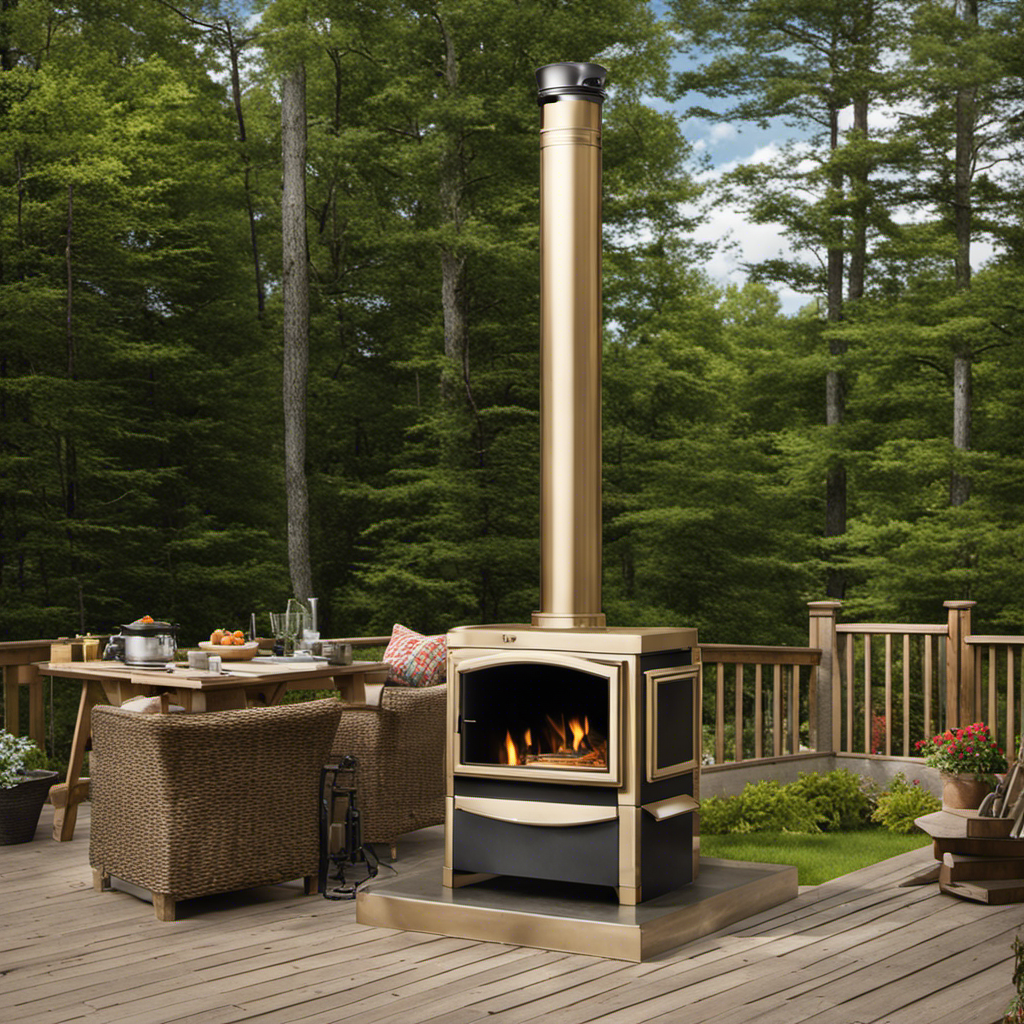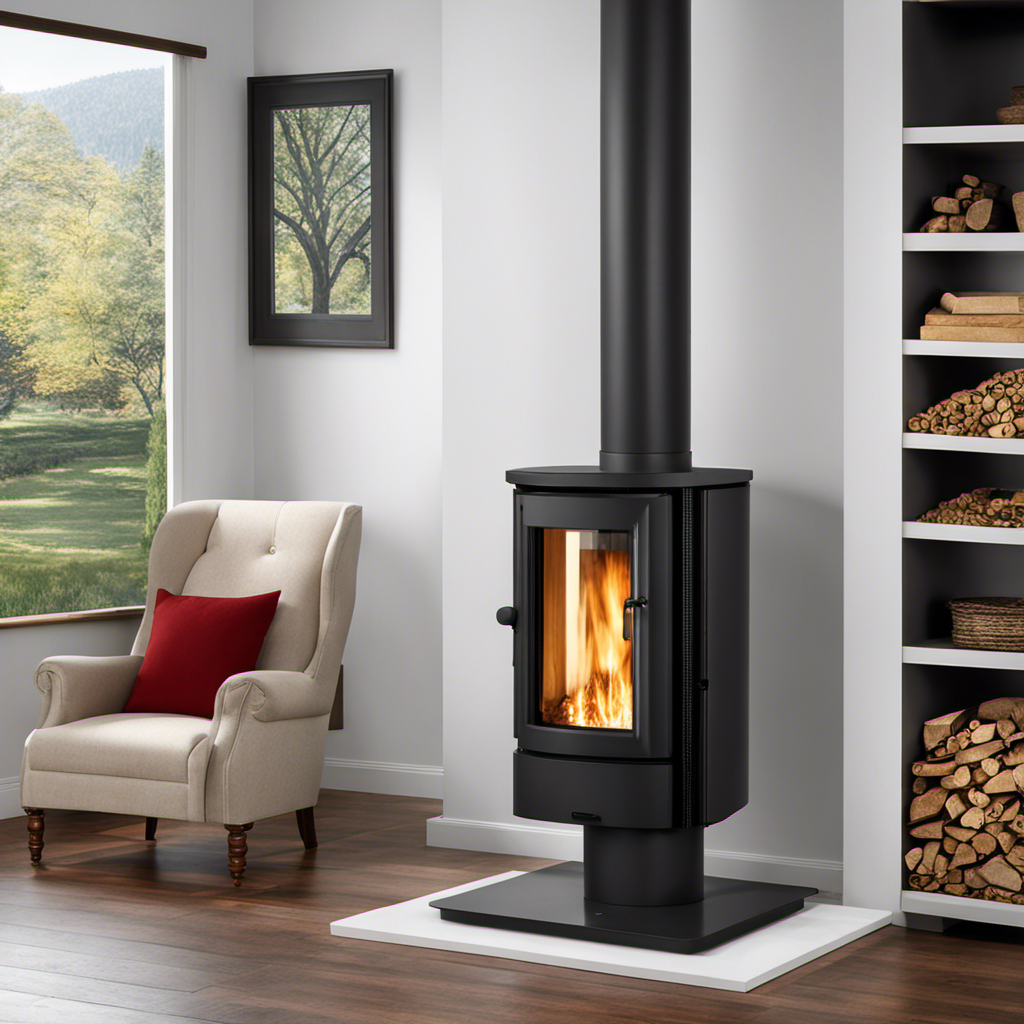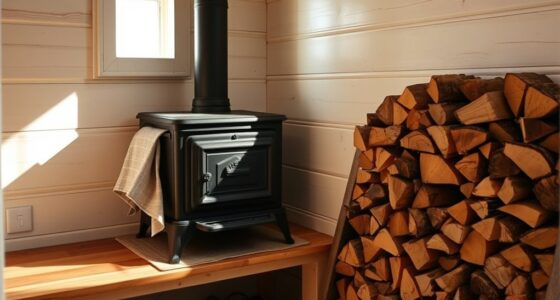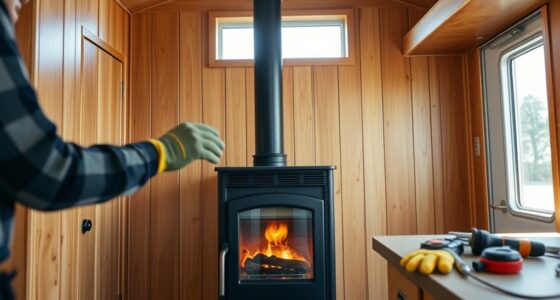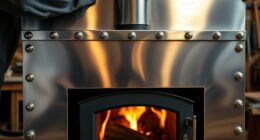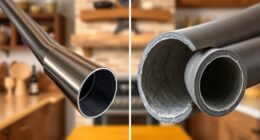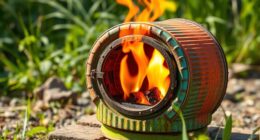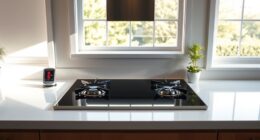During my quest to grasp the complexities of wood stove installation, I’ve learned that success hinges on ensuring the chimney is correctly set up.
In this guide, I’ll walk you through the step-by-step process of installing a Lowes wood stove chimney.
From understanding the components to choosing the right location, I’ll provide all the detailed instructions you need.
So, let’s roll up our sleeves and get ready to bring warmth and coziness to your home.
Key Takeaways
- Components work together for proper ventilation
- Regular cleaning and inspection are essential
- Choose the right location and materials for safety and efficiency
- Thoroughly prepare your home and follow local building codes and regulations
Understanding the Components of a Lowes Wood Stove Chimney
I understand the components of a Lowes wood stove chimney and how they work together to ensure proper ventilation. One common problem with chimneys is the buildup of creosote, a flammable substance that can cause chimney fires. To prevent this, regular cleaning and inspection are essential.
Another issue is blockage caused by debris, such as leaves or animal nests. This can restrict airflow and lead to poor ventilation. It’s important to install a chimney cap to prevent these blockages.
Additionally, safety precautions should be taken when using a wood stove chimney. This includes using a spark arrester to prevent sparks from igniting nearby combustible materials.
Regular maintenance and following safety guidelines will help ensure the efficient and safe operation of your Lowes wood stove chimney.
Choosing the Right Location for Your Wood Stove Chimney
There are two main factors to consider when choosing the right location for your wood stove chimney: safety and efficiency. It is important to select a location that minimizes the risk of fire and carbon monoxide buildup, while also maximizing the stove’s heating capabilities. Here are some essential safety precautions for wood stove chimney installation:
- Keep the chimney at least 2 feet above the highest point where it passes through the roof.
- Install a chimney cap to prevent birds, animals, and debris from entering.
- Use only approved materials for the chimney, such as stainless steel or insulated double-wall pipe.
- Ensure proper clearance from combustible materials, following manufacturer guidelines.
- Regularly inspect and clean the chimney to prevent creosote buildup.
By following these precautions and choosing the best materials for your wood stove chimney, you can enjoy a safe and efficient heating system for your home.
| Safety Precautions | Materials |
|---|---|
| Keep chimney above roof | Stainless steel or insulated double-wall pipe |
| Install chimney cap | Follow manufacturer guidelines for clearance |
| Regularly inspect and clean chimney |
Preparing Your Home for Wood Stove Chimney Installation
To ensure a smooth and successful wood stove chimney installation, it’s essential to thoroughly prepare your home and gather all the necessary materials.
When it comes to choosing the right materials for your wood stove chimney, there are a few key factors to consider. First and foremost, you’ll want to make sure that the materials are rated for high temperatures to prevent any potential fire hazards. Additionally, it’s important to choose materials that are durable and long-lasting, as a chimney is a substantial investment.
Common mistakes to avoid during wood stove chimney installation include failing to properly measure and plan for the chimney’s height and clearance requirements. It’s also crucial to follow all local building codes and regulations to ensure that your installation is safe and compliant.
Step-by-Step Guide to Installing a Lowes Wood Stove Chimney
I carefully followed the step-by-step guide and successfully installed a Lowes wood stove chimney with ease and confidence. It was a rewarding experience, knowing that I was taking the necessary steps to ensure the safety and functionality of my wood stove.
However, installing the chimney is just the beginning. Proper maintenance is crucial for the chimney to work efficiently and prevent any potential problems. Here are some important maintenance tips to keep in mind:
- Regularly inspect and clean the chimney to remove any creosote buildup.
- Check for any cracks or damage that may occur over time and repair them promptly.
- Ensure that the chimney cap is in good condition to prevent water and debris from entering.
- Keep an eye out for signs of chimney fires, such as excessive smoke or a strong, pungent odor.
Is a Permit Required for Installing a Lowes Wood Stove Chimney?
Yes, a permit for wood stove installation is required when installing a Lowes wood stove chimney. This is to ensure safety and compliance with local building codes. It’s important to check with your local building department to understand the specific requirements for obtaining a permit for wood stove installation in your area.
Tips for Maintaining and Troubleshooting Your Wood Stove Chimney
Regularly inspecting and cleaning the chimney, as well as promptly repairing any cracks or damage, are essential for maintaining and troubleshooting your wood stove chimney.
One of the most common chimney problems is the buildup of creosote, a flammable substance that can lead to chimney fires. To prevent this, it’s recommended to have your chimney professionally cleaned at least once a year.
Additionally, make sure to check for any obstructions such as bird nests or debris that could block the airflow.
Another common issue is the development of cracks or leaks in the chimney, which can cause smoke to seep into your home. If you notice any cracks, it’s crucial to repair them immediately using a high-temperature sealant.
Frequently Asked Questions
Can I Install a Lowes Wood Stove Chimney Myself, or Do I Need to Hire a Professional?
I can install a Lowes wood stove chimney myself, but it’s important to consider the pros and cons. DIY installation saves money, but hiring a professional ensures proper installation and compliance with local regulations.
How Often Should I Clean My Lowes Wood Stove Chimney?
I clean my Lowes wood stove chimney as often as I clean my teeth, which is to say, regularly. Signs that it needs cleaning include excessive smoke, a strong odor, or a decrease in stove efficiency.
What Type of Wood Should I Use in My Wood Stove to Maximize Efficiency?
To maximize efficiency in my wood stove, I use hardwoods like oak or maple. They burn longer and release more heat. It’s important to properly season the wood and ensure it’s dry for optimal performance.
Are There Any Specific Building Codes or Regulations I Need to Adhere to When Installing a Wood Stove Chimney?
Building code requirements and safety regulations must be followed when installing a wood stove chimney. It is important to ensure the chimney is properly installed and meets all necessary standards to ensure safety and compliance.
What Should I Do if I Notice a Leak or Smoke Coming From My Wood Stove Chimney?
If I notice a leak or smoke coming from my wood stove chimney, I would first inspect the chimney for any visible damage or cracks. Then, I would proceed with repairing chimney leaks and troubleshooting chimney smoke as needed.
Conclusion
To wrap things up, installing a Lowes wood stove chimney can be a rewarding project for any homeowner. By understanding the components, choosing the right location, and following a step-by-step guide, you can enjoy the warmth and comfort of a wood stove in your home.
Remember to regularly maintain and troubleshoot your chimney to ensure its efficiency and safety. So go ahead, embrace the cozy atmosphere and start enjoying the benefits of a wood stove chimney!
Logan’s affair with adventure began in childhood. He hailed from a small town where vast forests bordered one side and endless shores stretched on the other. His days were spent exploring uncharted woods, climbing tall trees, or listening to the tales of old sailors. This early immersion in a world brimming with stories and mysteries became the foundation of his passion for writing.

